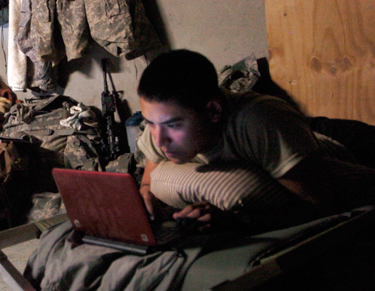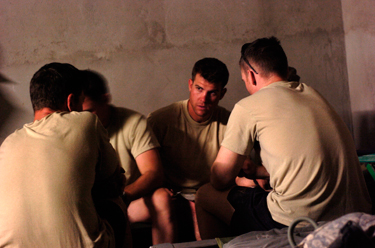On this trip, 2nd Platoon would just stay overnight, using Margah as a jumping-off point for their mission. Whichever platoon was there on 30-day rotation patrolled day and night and pulled guard-duty shifts with boredom broken by frequent rocket attacks.
 Well, at least the accommodations were luxurious. Margah is a stone-walled compound about 600 yards long and half that wide, with watchtowers at each corner, manned by the Afghan National Army or Afghan Border Police. Inside are three buildings: a living and operational space for the Americans, a vehicle storage building with heavy weapons emplacements on the roof, and a third with barracks for the Afghan military. “Primitive” and “austere” don’t come close to describing the conditions.
Well, at least the accommodations were luxurious. Margah is a stone-walled compound about 600 yards long and half that wide, with watchtowers at each corner, manned by the Afghan National Army or Afghan Border Police. Inside are three buildings: a living and operational space for the Americans, a vehicle storage building with heavy weapons emplacements on the roof, and a third with barracks for the Afghan military. “Primitive” and “austere” don’t come close to describing the conditions.
Chow is almost exclusively MREs, with the occasional feast of steaks — which quickly become the best steaks ever eaten. There is no heat or air conditioning, no telephone or internet connections. Inside, the bare concrete walls are crowded with cots where the soldiers sleep in shifts, if they can sleep at all. Every square foot of floor space is covered with personal items and weapons. Ammunition is stacked in the halls, and the operations center is full of communication and video gear. There’s plenty of free time, and the soldiers use it to sleep, listen to music, play computer games, and work out in the gym.
There is a very distinctive odor to the combat outpost and everyone in it. Many of the soldiers don’t shave every day, get haircuts, or change their uniforms. The “facilities” are two Portacans; the output is collected in bags and burned. Showers are ice cold — if the tanks have been filled. Many soldiers warm water in bottles out in the sun, if they take a shower at all, and most don’t. By the time the soldiers finish their rotation there, they look a bit like well-armed homeless people.
On its second morning, 2nd Platoon struck out for Hill 2600, near a mountain called Patrón (like the tequila — the American military has named local mountains for liquors and local roads for vehicles). Their mission was to lie in ambush on a site from which the enemy has often launched rocket attacks. The Americans have shot so much artillery at the site that the ground is covered in the steel fragments of shells. Tripod holes in the ground showed where insurgents had set up their rocket launcher, time and time again. This time, if the enemy walked into the “kill box,” the platoon would destroy them.
 It was an exhausting climb, but the first few hours were uneventful. Then around 3 p.m., the platoon began to take mortar fire. The first round hit far away, but the enemy gunner made a fast adjustment, and the next two rounds exploded within 100 meters of the troops. This was not part of the plan.
It was an exhausting climb, but the first few hours were uneventful. Then around 3 p.m., the platoon began to take mortar fire. The first round hit far away, but the enemy gunner made a fast adjustment, and the next two rounds exploded within 100 meters of the troops. This was not part of the plan.
Jarmuz immediately called for artillery support from Boris and air cover from the Apache gunships. When the helicopters arrived overhead, the insurgents tried to shoot them down with a heavy machine gun.
The Apaches fought for almost three hours, making runs to OE to refuel and rearm. The day ended with a spectacular air strike. The 2,000-pound bomb stopped the fight long enough for the platoon to continue up the mountain another 500 meters, where they settled in for the night. While there was no longer much chance to plan an ambush, their presence would certainly draw the insurgents into a fight.
The next morning, Jarmuz had spread his platoon across a north-south ridgeline, facing east. Pakistan was less than two kilometers away, and chatter from enemy radios made the unit uneasy.
Besides the basic fighters, the platoon included Pfc. Griechen, the battlefield medic; Sgt. Erik Butler a forward observer responsible for calling in artillery; and a soldier wielding the 60mm mortar. Sixty yards behind them, two Air Force specialists were there to call in air strikes, along with two men from Army intelligence and an interpreter.
As soon as the sun came up, Butler called in information to pinpoint the most likely avenues from which the enemy might attack — it would make artillery strikes faster and more accurate.
Around 2:30 p.m., all hell broke loose. The platoon started taking rocket-propelled grenade (RPG) fire from the northeast and rifle fire from the east and southeast. The firing was intense, and mortars began to fall nearby.
A single grenade hit a tree at the platoon’s command position, nicking Jarmuz in the neck and damaging Butler’s eardrum. But it did the most damage to Sommers, who’d been closest to the impact. A fragment penetrated his helmet and skull, laying open his brain. He was also bleeding heavily from neck and thigh wounds. The whole platoon began to return fire. Roberson started doing what he could for Sommers, and the call went out for “Doc.”
Butler, at Jarmuz’ order, immediately called FOB Boris, asking for its long-range artillery to lay down suppressing fire. But the platoon knew it could take as long as 30 minutes to get that started — a lifetime in battlefield terms. Not because Peacock and his gun crews were slow, but because of the peculiar rules of engagement that the Americans fight under in Afghanistan. Higher-ups in the battalion command structure had to check maps to see whether the insurgents’ position was too close to any buildings. If it had been, permission to fire would have been denied. Abu Company knew that, in this case, there were no buildings around.
In the meantime Griechen had heard the medic call. He was about 100 yards from the command post, and as soon as he started moving, it felt like every insurgent in the hills started shooting at him. He was pinned down, along with two others.
Finally there was a lull, and all three broke cover and ran for the command post. Griechen fell down several times — but the last, at least, was a lucky move. One of his buddies said later that the last time the medic fell, machine-gun fire whistled right through where his head would have been.
{gallery}01122011{/gallery}











